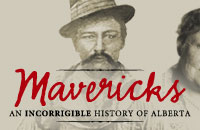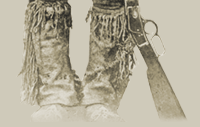

 |
|
The Mavericks: An Incorrigible History of Alberta resource contains hundreds of historical primary source materials that are "real" history. They are the personal affects, clothing, weapons, tools, photographs, documents, artwork, and maps from the individuals who are a part of Alberta's history. These primary source materials have been digitized from the collections of the Glenbow museum in Calgary and represent almost 40 different "Mavericks" who made Alberta what it is today. "Historical Thinking" in the Alberta Social Studies CurriculumPrimary sources allow students and teachers to become actively engaged with history and learn about the actual people involved. Students do not just "learn" or memorize history, they are able to actually become historians themselves. They will acquire and develop historical thinking strategies that will assist them in constructing their own understandings and apply what they learn by judging different historical perspectives that may be different from their own. Historical thinking skills involve the positioning of people, places, ideas, and events within a historical context and assist students in developing a "sense of time and place" for the past that aids their definition of the present. Primary Versus Secondary SourcesA primary source is a first-hand, original, authentic account of the past. They are the actual records or evidence of historical figures and events and tell the "story" of the past. They are often a one of a kind item that was owned or created by someone who was there to actually, "see it happen." Primary sources are often one-of-a-kind and can be oral histories, diaries, personal letters, photographs, special objects, tool, weapons, family heirlooms, documents, autobiographies, and even newspapers. A secondary source is a second-hand, narrated report or description of the past. They were created after the actual events of the time period. They may contain an argument, opinion, or bias, as the account may have been written from the specific point of view of one author. Secondary sources can be textbooks, historical movies, historical novels, and biographies. Why Should Students Analyze Primary Sources in Social Studies?
Most students and parents believe that learning about history is a process of memorizing the facts and dates of specific events on a timeline. They assume that the writing included in their textbook is the one and only definitive version of history. The use of primary sources to examine history will allow students to begin to see that historians examine the available evidence and create their best interpretation of the events. A popular saying, "History is written by the victors," hints that there are many different points of view toward any sets of events. Any teacher involved in sorting out an argument on the school playground knows that each individual involved will have a different point of view toward the same event and may disagree on the "facts." "History will be kind to me for I intend to write it." Sir Winston Churchill (1874-1965) Primary sources present the "human" side of history. They can be related to great historical figures or to a common person of the time period. Students are able to step into the actual lives of these characters from history rather than merely reading about them. The values, attitudes, opinions, beliefs, and ways of life of these individuals come shining through, connecting students to the actual stories of genuine persons. The Primary Source Inquiry ProcessStudents, by using primary sources, will undertake a similar process as a historian by analyzing the evidence. They will argue and debate about their interpretations of the artifacts. They will be forced to explain the evidence that led them to form their point of view, using critical and historical thinking to justify their opinions. Participating in these discussions and deliberations compel students to examine the subjectivity involved in the historical process, understanding that the analysis and significance attributed to a specific artifact may be disputed by different individuals. "History is the version of past events that people have decided to agree upon." Napoleon Bonaparte (1769-1821) In order for students to form a thorough analysis, they will develop and use their skills of observation, as well as create logical inferences based on their inspection of the primary source. They will have to ask essential questions, find and examine other sources of evidence or information, creatively and critically analyze their findings, connect the artifact to its specific historical context, present their judgments in a persuasive, coherent manner, and support their opinions when confronted with different viewpoints of their own. Primary source materials can provide a great deal of information on the cultural, social, and historical viewpoints of individuals, reflecting the stories and anecdotes of the people who made or used them. As an extension of a primary source artifact inquiry, students could tell the "story" of that artifact, document, or photograph, incorporating all their knowledge and understanding of the owner or creator, their way of life, their opinions and values, specific events in their lifetime, as well as their achievements and struggles. Blackline Masters for Students - Primary Source Inquiry ProcessPrimary historical sources change the way we look at history by allowing students to construct their own point of view toward historical figures and events. Undertaking historical object-based inquiry activities pushes students to actively discover, investigate, research, question, and analyze his or her own understanding of the past. The process urges students to use and improve upon critical and creative thinking, logical reasoning and analytical reflection, all within a real historical context
The four documents have been created to guide students through an analysis of primary source materials. They should begin by asking and developing their own questions about a particular primary source, then move on to examine questions that are appropriate for their artifact. Using a journaling style of writing will enable students to ask their own questions, develop answers, reflect on their findings, and examine what they have learned or still need to learn about their primary source material.
|
![]()
Mavericks Home
| Teacher Resources Home |
Student Resources
Help
| Contact | Site
Map | Credits
© Copyright Glenbow Museum, 2006. All Rights Reserved
